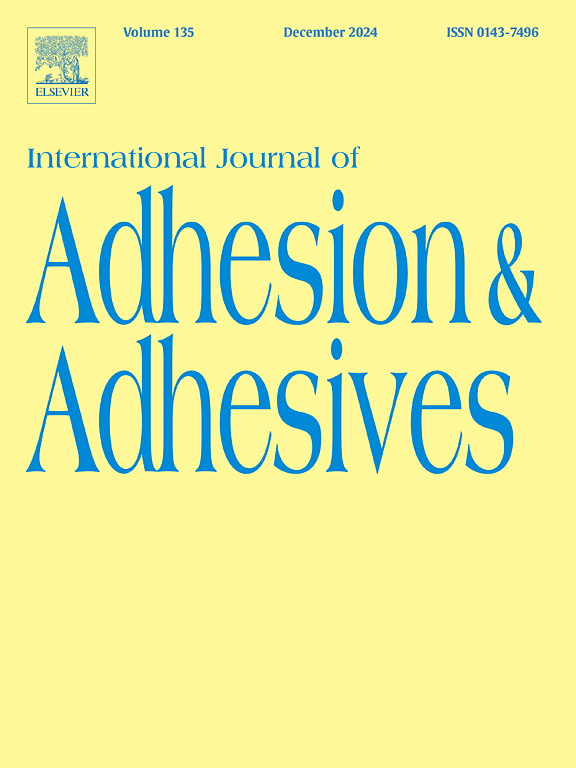用甘油和马来酸酐基聚酯改性低粘度沥青成高粘度沥青
IF 3.2
3区 材料科学
Q2 ENGINEERING, CHEMICAL
International Journal of Adhesion and Adhesives
Pub Date : 2025-06-18
DOI:10.1016/j.ijadhadh.2025.104087
引用次数: 0
摘要
在这项研究中,利用合成聚酯将低粘度级沥青升级为高粘度级沥青。以马来酸酐(M)和甘油(G)为单体,在优化的温度、时间和摩尔比条件下进行缩聚反应,得到了16种不同的聚酯。其中一种聚酯M3G1H5 (M:马来酸酐,G:甘油,H:时间)因其最佳的粘弹性性能而被确定为最有效的沥青改性聚酯。这种特殊的配方导致三种聚酯改性沥青与基础沥青(VG10)以6 - 15%的浓度混合。改性沥青,严格按照ASTM标准测试,显著提高软化点,粘度和延展性。值得注意的是,除了60°C下的绝对粘度要求外,两种配方均符合IS 73:2013的VG30和VG40规格。流变学分析证实了其优异的车辙性和抗变形性,表明聚酯在提高性能方面的作用。采用滚动薄膜烘箱(RTFOT)对合成的改性沥青进行了短期老化试验,结果表明,聚合物在沥青介质中分布均匀,并保持了沥青的粘弹性。采用多准则决策分析(Multi-Criteria Decision Analysis, MCDA)对不同沥青品种在不同环境和交通条件下的适用性进行了评价,得出聚酯改性沥青适合各种气候条件和交通状况的结论。这些发现突出了合成聚酯在将低等级沥青提升到适合现代建筑需求的高性能等级方面的关键作用,从而为沥青改性指明了一条有前途的途径。本文章由计算机程序翻译,如有差异,请以英文原文为准。

Modification of lower viscosity grade bitumen into higher viscosity grade bitumen via glycerol and maleic anhydride-based polyester
In this study, a synthetic polyester is utilized to upgrade low-viscosity grade bitumen into higher-viscosity grades. A polycondensation of maleic anhydride (M) and glycerol (G) monomers was conducted under optimized temperature, varied time, and molar ratios, resulting in the synthesis of 16 different polyesters.One of the polyester M3G1H5 (M: maleic anhydride, G: glycerol, and H: time) was identified as the most effective polyester for bitumen modification due to its optimal viscoelastic properties. This specific formulation resulted in three polyester-modified bitumens blended with base bitumen (VG10) in 6–15 wt% concentrations. The modified bitumens, rigorously tested as per ASTM standards, significantly improve softening point, viscosity, and ductility. Remarkably, two formulations met the VG30 and VG40 specifications as per IS 73:2013, aside from the absolute viscosity requirement at 60 °C. Their superior rutting and deformation resistance was confirmed by rheological analysis, indicating polyesters' role in boosting performance. Furthermore, the synthesized modified bitumen was subjected to short-term aging using a rolling thin film oven test (RTFOT), revealing that the polymer was uniformly distributed in the bitumen medium and retained the viscoelastic properties of the bitumen. The suitability of different bitumen variants across varying environmental and traffic conditions was evaluated using the Multi-Criteria Decision Analysis (MCDA), and it was concluded that polyester-modified bitumens are suitable for various climatic conditions and traffic situations.These findings highlight the pivotal role of the synthesized polyester in elevating lower-grade bitumen to high-performance grades suitable for modern construction demands, thereby indicating a promising avenue for bitumen modification.
求助全文
通过发布文献求助,成功后即可免费获取论文全文。
去求助
来源期刊

International Journal of Adhesion and Adhesives
工程技术-材料科学:综合
CiteScore
6.90
自引率
8.80%
发文量
200
审稿时长
8.3 months
期刊介绍:
The International Journal of Adhesion and Adhesives draws together the many aspects of the science and technology of adhesive materials, from fundamental research and development work to industrial applications. Subject areas covered include: interfacial interactions, surface chemistry, methods of testing, accumulation of test data on physical and mechanical properties, environmental effects, new adhesive materials, sealants, design of bonded joints, and manufacturing technology.
 求助内容:
求助内容: 应助结果提醒方式:
应助结果提醒方式:


